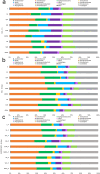Effects of sulfamethoxazole and copper on the natural microbial community from a fertilized soil
- PMID: 39540947
- PMCID: PMC11564247
- DOI: 10.1007/s00253-024-13324-x
Effects of sulfamethoxazole and copper on the natural microbial community from a fertilized soil
Abstract
Cattle manure or its digestate, which often contains antibiotic residues, can be used as an organic fertilizer and copper (Cu) as a fungicide in agriculture. Consequently, both antibiotics and Cu are considered soil contaminants. In this work, microcosms were performed with soil amended with either manure or digestate with Cu and an antibiotic (sulfamethoxazole, SMX) co-presence and the planting of Lactuca sativa. After the addition of the organic amendments, a prompt increase in the microbial activity and at the same time of the sul1 and intI1 genes was observed, although ARGs generally decreased over time. In the amended and spiked microcosms, the microbial community was able to remove more than 99% of SMX in 36 days and the antibiotic did not bioaccumulate in the lettuce. Interestingly, where Cu and SMX were co-present, ARGs (particularly sul2) increased, showing how copper had a strong effect on resistance persistence in the soil. Copper also had a detrimental effect on the plant-microbiome system, affecting plant biomass and microbial activity in all conditions except in a digestate presence. When adding digestate microbial activity, biodiversity and lettuce biomass increased, with or without copper present. Not only did the microbial community favour plant growth, but lettuce also positively influenced its composition by increasing bacterial diversity and classes (e.g., Alphaproteobacteria) and genera (e.g., Bacillus), thus indicating a good-quality soil. KEY POINTS: • Cattle digestate promoted the highest microbial activity, diversity, and plant growth • Cattle digestate counteracted detrimental contaminant effects • Cu presence promoted antibiotic cross-resistance in soil.
Keywords: ARGs; Antibiotics; Cattle manure; Cattle manure digestate; Lettuce; Plant-microbiome system.
© 2024. The Author(s).
Conflict of interest statement
Figures






References
-
- Adedayo AA, Fadiji AE, Babalola OO (2022) Plant health status affects the functional diversity of the rhizosphere microbiome associated with Solanum lycopersicum. Front Sustain Food Syst 6:894312. 10.3389/fsufs.2022.894312
-
- Ali H, Khan E, Ilahi I (2019) Environmental chemistry and ecotoxicology of hazardous heavy metals: environmental persistence, toxicity, and bioaccumulation. J Chem 2019:1–14. 10.1155/2019/6730305
-
- Allison LE, Moodie CD (1965) Carbonate. In: Black CA (ed) Methods of soil analysis. Part 2. Chemical and microbiological properties. American Society of Agronomy, Madison, pp 1379–1396
MeSH terms
Substances
Grants and funding
LinkOut - more resources
Full Text Sources

